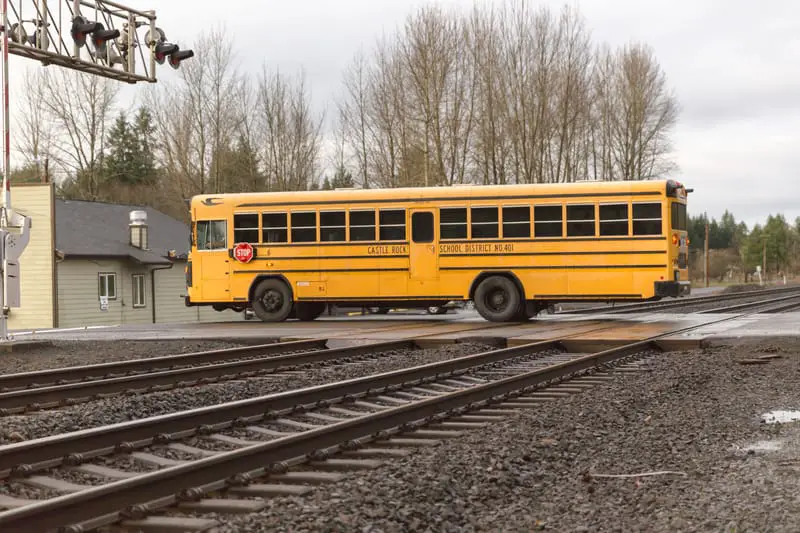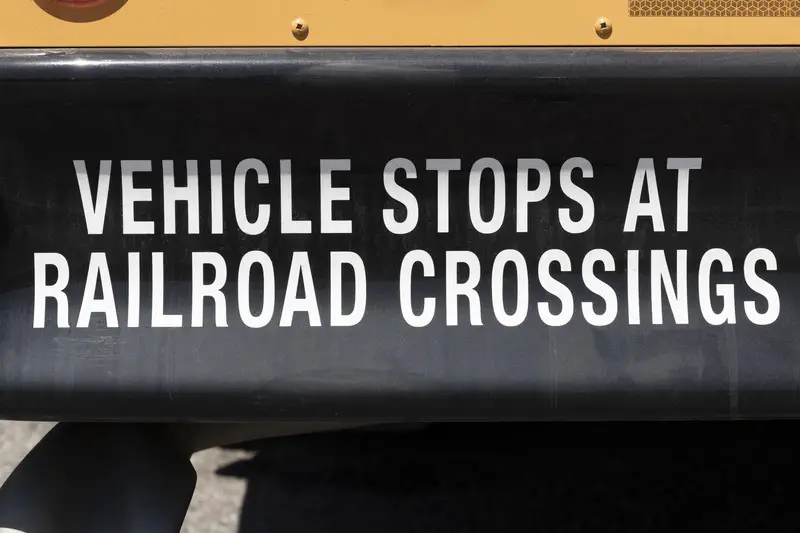
Buses were introduced into society more than 200 years ago. Since then, they have been responsible for continuously advancing human civilization, enhancing economic growth, and linking enormous countries.
However, many people have died in tragic and avoidable bus accidents, which eventually became why a law forcing buses to stop at railroads was introduced.
Buses in America must come to a complete stop at railroads for safety purposes. 80 years ago, a horrific bus accident resulted from a bus failing to stop at a railroad before fatally colliding with a train. Bus drivers must open their windows and front door before crossing a railroad.
The bus that collided with a train at a railroad more than 80 years ago was the catalyst for the federal government to implement updated and stringent laws. The modernized laws, which are still in place today, state that a bus driver must legally come to a complete stop at any railroad.
In addition, they are legally bound to wind down the driver-side window, open the front door, and listen for oncoming traffic.
Why Buses Must Stop At Railroads
It may seem logical for buses to stop and check for oncoming traffic at any railroad in America. However, before 1938, buses often crossed railroads without accounting for oncoming traffic.
The practice of buses crossing railroads without thoroughly checking for oncoming rail traffic resulted in many horrific and avoidable accidents in the United States. Often buses would drive directly through railroads, not accounting for the warning signs or any oncoming traffic.
While the practice did not always result in terrible loss of life, on rare occasions, the driver would time their railroad crossing incorrectly, which resulted in an enormous train hitting their vehicle side-on, instantly killing every innocent soul on board.
As with most modern laws, one single horrific occurrence set the wheels of justice into motion. In December 1938, one of Utah’s worst bus and train collisions occurred. On that fateful night, there was an intense snowstorm in the region. The snowstorm negatively impacted the driver’s powers of concentration and visibility.
Why Was The Horrific 1938 Accident So Important?
Despite the 1938 bus and train accident resulting in many innocent lives being lost, it indirectly saved thousands of lives as it directly did.
The event catalyzed transportation industry legislature modernization as the significant public outcry forced the government’s hand.
While the bus driver, Slim Silcox, did not drive directly through the railroad without checking, he did cross it before ensuring that there was no oncoming train. The bus drivers’ lack of severe negligence demonstrates the importance of the pioneering 1940 law alteration.
Tragically, after the driver paused, he decided to cross the railroad with 55 school-aged children on board. At that moment, an 80-car freight traveling more than 50 miles per hour hit the center of the bus, killing everyone on board.
Following the horrific incident, one of many that occurred in the 20th century, American lawmakers and the public decided to introduce various laws to prevent similar accidents from ever transpiring again.
The law, introduced in early 1940, was pioneering at the time. It stated that bus drivers must stop at any railroad before opening their window and the side door to thoroughly listen for any oncoming train traffic.
Since the law was introduced, horrific bus and train accidents have been reduced by more than 90%, demonstrating the importance of appropriate transportation regulations.
When Were Buses Stopping At Railroads Made Mandatory?

- This sign is shown on all school buses in America
A law, which applies to all 50 American states, was introduced in early 1940. The law aimed and was successful in significantly reducing tragic bus accidents occurring on railroads.
The tragic accident in Utah was the catalyst for American legislature alterations. After hearing the enormous public outcry, American lawmakers decided to consult with transportation industry experts before introducing the law that is still currently applicable.
What Happened At The 1938 Utah Bus Incident?
The bus driver, Slim Silcox, failed to spot an oncoming train on that fateful night in 1938. After pausing to check for oncoming train traffic, he crossed the railroad just as an oncoming train approached.
While the unfortunate bus driver was not completely irresponsible, he failed to thoroughly listen and search for trains running on that line.
Sadly, as he chose to progress over the railroad, an 80- car freight train appeared out of the blizzard, colliding with the side of the bus and instantly killing everyone on board.
Despite the train driver slamming on the brakes once he spotted the bus, it was too late, and the horrific accident couldn’t have been avoided.
The impact and scale of the accident cannot be understated. Such was the weight and speed of the 80-car train; the bus was eventually discovered more than half a mile down the railway line.
When the first respondents, law enforcement and emergency services, arrived at the scene, they were shocked at what they saw.
Seeing badly mangled bodies of children, teenagers, and adults were too much for even the most experienced first respondents to deal with, resulting in a significant and appropriate public outcry.
Why Did The 1938 Accident Cause An Enormous Public Outcry?
1938 was more than 80 years ago, meaning that social media and television were not prevalent in American society.
The lack of modern media outlets, led to emergency services taking more than a month to accurately identify the mangled bodies of all the innocent victims.
The resulting public pressure and American lawmakers’ ambition to modernize transportation systems led to the law being introduced throughout all 50 states in early 1940.
While 5 people managed to survive the initial impact, they tragically passed away after bravely fighting in the hospital for a few days. In addition, the bus driver known as Slim Silcox was instantly killed on impact.
The deaths of everyone involved in the accident are sickening, although that one incident has been credited with permanently changing the American transportation legislature.
Many people fail to fully comprehend the incident’s significance and the pioneering safety regulations introduced shortly after it occurred.
The law is so powerful that it legally binds all bus drivers to stop when approaching a railroad. Once the bus driver is completely idle, the driver must fully open their window before opening the side door.
After the window and door have been correctly opened, the driver should carefully listen for any oncoming train traffic.
While the law may seem harsh regarding its fundamental outcomes and applications, it has been directly responsible for preventing hundreds of thousands of avoidable transportation-related deaths.
Conclusion
Buses stop at railroads for safety purposes, with its introduction aiming to prevent horrific accidents between buses and oncoming train traffic.
Before the law forbade bus drivers from coming to a complete stop at railroad intersections in early 1940, bus drivers could drive straight through without thoroughly checking for oncoming train traffic.
